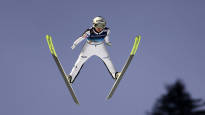Ski jumping history is being made today in Vikersund, Norway, when female ski jumpers compete for the first time on a flying hill. There are 15 competitors, one of which is from Finland Jenny Rautionaho.
Vikersund is part of the Raw Air tour competing in Norway, but it is not a World Cup competition. The best 15 of the tour took part in the Vikersund race.
The 26-year-old Rautionaho has gotten a feel for Vikersund’s flying hill in training.
– We are going into the unknown, but at the same time you have to jump from there like from any hill, Rautionaho states.
Urheilu’s expert and in his own career also had fun at the airfield Janne Ahonen says that in the first women’s flying hill race we are going towards the unknown.
Vikersund has seen big differences in men’s competitions. According to Ahonen, 15 athletes is an acceptable number for the women’s competition.
– The Vikersundi hill in particular is such that there are terrible differences between a good and a weaker jumper. If the standard team of the World Cup were involved, the best would jump, for example, 220 meters, and the weaker ones would be less than a hundred meters.
– Now that there are only 15, the differences are better kept in check.
On Saturday, a Slovenian managed to fly over 200 meters as the first woman in history Ema Klinec24, whose jump carried 203 meters.
However, a 19-year-old Canadian flew the longest Alexandria Loutitt. Her best jump was 222 meters, which was naturally a women’s world record.
Lout tune in to NRK (you will switch to another service) jumping to be “magical”.
– Getting to Lentomäki has been a long battle for us. The whole group that gets to do this together is incredibly happy and we celebrate as a group when someone jumps well. Such moments are never forgotten.
Rautionaho went the furthest in three test laps in his last attempt, but the effort still didn’t hit. He reached 147 meters.
“Always new”
Jumping from an airfield is clearly on the margins in ski jumping. In the Men’s World Cup, there are 2–3 competitions per season.
There are only five flying hills in Europe. The sport’s world championships are held every two years.
Ahonen says that you can never get used to ski jumping enough.
– From there, we jump a couple of races, then there is a ten-month break and we jump a couple of races again. In that sense, it is always new.
According to Ahonen, jumping from a flying hill requires, above all, credit towards one’s own jumping. The technology must be in order.
– When you go there for the first time, you have to trust that you can do the same things on the bow as on Suurmäki. If you are careful, it can become dangerous.
According to Ahonen, the flying hill is a bigger challenge for a small jumper.
– All forces and resistances are more severe for women due to their smaller and lighter size. When you have jumped from there before, of course there is some mental image. You just have to have the confidence to do it.
ME talkies of the Norwegians
Ahonen won, among other things, four individual World Cup medals at the airport. During the flying hill race, he didn’t think about the rankings.
– Focused and respected the hill. You knew that when you do things well, there is a chance to succeed.
Ahonen says that aerial ski jumping has changed over the years because of the hill’s profiles. In the old days, jumpers came from really high.
The pace has also slowed down.
– When the profiles have changed, let’s jump forward more. At no point is the jump as high as it used to be. Today there is more surface gliding. When the skis and suits became more sticky, we jump at a quieter speed than when I jumped the first few times.
In the 2004–2005 season in Planica, Ahonen fell at the end of a 240-meter jump. That would have been a new world record.
The current world record is held by Austria Stefan Kraft. He cut 253.5 meters in 2017 in Vikersund.
Since 2005, ten world records have been set. Seven of them are made by a Norwegian. They are Tommy Ingebrigtsen, Björn Einar Romören, Johan Remen Evensen, Anders Fannemel mixed Robert Johansson.
– The Norwegians have traditionally been good at flying hills. They take the jump strongly forward. That kind of technology works in the airfield. For example, the Germans jump with a not so forward technique, which is why they don’t do so well on the flying hill.
How is the technology applicable?
A pioneer of Finnish women’s ski jumping Heli Pomell says that the lentomäki race has come surprisingly quickly for women. She reminds that it is only two years since the women competed at the World Cup level for the first time in Suurmäki.
– The tip certainly jumps very well. Some of the technology is such that it is much better suited to a smaller hill.
According to Pomelli, even with the current team, the differences in the flight deck can be really big.
– The differences have leveled out considerably. But the race will show whether the flying hill is the right solution. Maybe for a few years it would have been possible to still jump in suurmäki and then go to the flying hill when the technique has been refined.
